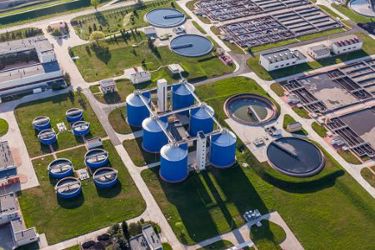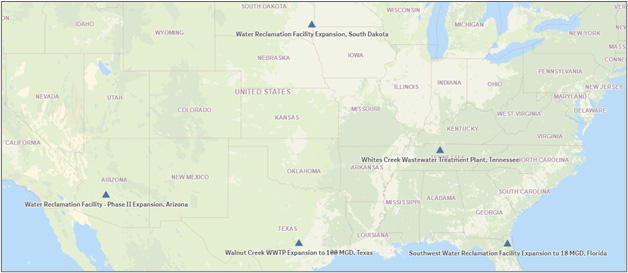Wastewater Management Investments: A Look At 5 Large U.S. Wastewater Treatment Projects Set For 2024
By David Cox, PE

According to the Environmental Protection Agency (EPA), more than 75% of the U.S. population is served by approximately 16,000 municipal wastewater treatment facilities. On average, these facilities operate at around 81% of their design capacities, with 15% operating at or above their threshold. The American Society of Civil Engineers (ASCE) assigned a discouraging D+ grade to the nation’s wastewater infrastructure in its 2021 infrastructure report card. While the situation may not seem promising, it does, in fact, present numerous opportunities for companies specializing in the construction or rehabilitation of wastewater treatment infrastructure.
Various federal funding opportunities are available to enhance the wastewater treatment infrastructure nationwide. One such program, the Water Infrastructure Finance and Innovation Act (WIFIA), has already disbursed $8 billion in loans for 42 wastewater infrastructure projects. The Bipartisan Infrastructure Law (BIL) allocates $11.71 billion through the Clean Water State Revolving Fund. This funding is aimed at assisting local communities and publicly owned treatment systems in financing projects related to decentralized wastewater treatment systems and other initiatives associated with managing wastewater and stormwater.
FirmoGraphs is dedicated to monitoring infrastructure projects from the beginning, starting with the conceptual phase and continuing to their commercial operation. This data is thoughtfully organized in a centralized database and presented through dynamic dashboards and maps. By following this approach, we can provide invaluable business insights to a broad spectrum of market participants, including U.S. infrastructure contractors, architects, engineers, and consultants, allowing them to establish a solid competitive foothold in the industry. This article covers five (5) examples of large wastewater treatment projects coming soon to a utility near you.

Location of five large wastewater treatment projects for 2024. Source: FirmoGraphs
5 Large Wastewater Treatment Projects In The U.S.
FirmoGraphs analyzed capital improvement plans (CIPs) of 100s of public wastewater agencies across the U.S. and selected five projects in geographically diverse areas valued at $100 million or more that are anticipated to commence construction in 2024.

Project Summaries
Walnut Creek WWTP Expansion to 100 MGD
The City of Austin Water, Texas, plans to expand the Walnut Creek Wastewater Treatment Plant (WWTP) from its current capacity of 75 million gallons per day (MGD) to 100 MGD and its peak hourly flow capacity from 165 MGD to 300 MGD. The project will involve the construction of new facilities and rehabilitating and upgrading existing facilities to meet future demands and regulatory requirements for wastewater treatment. The project has been mentioned in our previous article, and we found an update on the final project with an increase in cost from $284 million to $500 million. The construction is anticipated to begin in the Fall of 2024.
Whites Creek Wastewater Treatment Plant
The Whites Creek Wastewater Treatment Plant is a significant wastewater treatment project undertaken by Metro Water Services (MWS) to upgrade and expand the existing facility in Nashville, Tennessee. The project aims to improve the quality of the treated water discharged into the Whites Creek and Cumberland River. The project will upgrade primary and secondary treatment systems, replace UV disinfection equipment, install fine-bubble aeration, upgrade blowers, replace headworks, and modernize the solids handling facility. The project is anticipated to start construction in 2024 and be completed by 2029, costing more than $403 million.
Southwest Water Reclamation Facility Expansion to 18 MGD
The Manatee County Utilities, Florida, proposed to upgrade the Southwest Water Reclamation Facility (SWWRF) to expand the capacity of the existing wastewater treatment plant from 14 to 18 MGD. The SWWRF expansion project includes upgrades such as replacing Splitter Box No. 1, adding two 0.5375-million-gallon anoxic basins, constructing Splitter Box No. 3, and incorporating two 1.0-million-gallon aeration basins. It also involves enhancing air distribution, upsizing piping, building a 125-ft diameter secondary clarifier, and creating a new return activated sludge (RAS)/waste activated sludge (WAS) pump station. The project also includes retrofitting existing automatic backwash (ABW) filters and improving chlorine contact chambers with effluent finger weirs. The project is expected to commence in 2024, costing over $193 million.
Water Reclamation Facility Expansion
The City of Sioux Falls Public Works, South Dakota, is embarking on a significant water reclamation facility (WRF) expansion project following a master plan completed in 2018. It will increase the WRF's capacity to 28 million MGD by 2040 and 35 MGD by 2060. The project will also upgrade the existing infrastructure and equipment to meet current and future regulatory standards, including enhancements to primary clarifiers, the introduction of new digesters for biosolid processing and stabilization, the establishment of a biosolids dewatering complex, storage for biosolids, improvements and expansions to the cascade aeration structure, and other miscellaneous enhancements. The project is scheduled to commence construction in 2024, costing approximately $116 million.
Water Reclamation Facility ‐ Phase II Expansion
The Water Reclamation Facility (WRF) ‐ Phase II Expansion is a major wastewater treatment infrastructure project by the City of Avondale Public Works, Arizona. This project aims to increase the WRF's average daily maximum capacity from 9 million MGD to 12 or 15 MGD to accommodate expected growth in the area. The key components of this project include expanding capacity, upgrading headworks equipment, modernizing instrumentation and electrical systems, enhancing secondary treatment processes, implementing disinfection methods, upgrading solids handling systems, and making any necessary plant process improvements to meet the 12 MGD demand. The project is slated for construction in 2024, with completion in 2026, costing approximately $109 million.
 Dave Cox is the president and founder of FirmoGraphs, a business focused on applying Business Intelligence (BI) to North American industrial and utility operations (see www.firmographs.com). He earned a BS in Civil Engineering from the University of California at Berkeley, and an MS from the University of Texas at Austin in environmental engineering. He is a California Professional Civil Engineer. Dave has spent his 30-year career doing engineering, marketing, and sales work with asset-intensive organizations in the energy, water, oil, and technology industries. He is passionate about using data to help North American industry make better decisions to improve both financial performance and the environment.
Dave Cox is the president and founder of FirmoGraphs, a business focused on applying Business Intelligence (BI) to North American industrial and utility operations (see www.firmographs.com). He earned a BS in Civil Engineering from the University of California at Berkeley, and an MS from the University of Texas at Austin in environmental engineering. He is a California Professional Civil Engineer. Dave has spent his 30-year career doing engineering, marketing, and sales work with asset-intensive organizations in the energy, water, oil, and technology industries. He is passionate about using data to help North American industry make better decisions to improve both financial performance and the environment.
